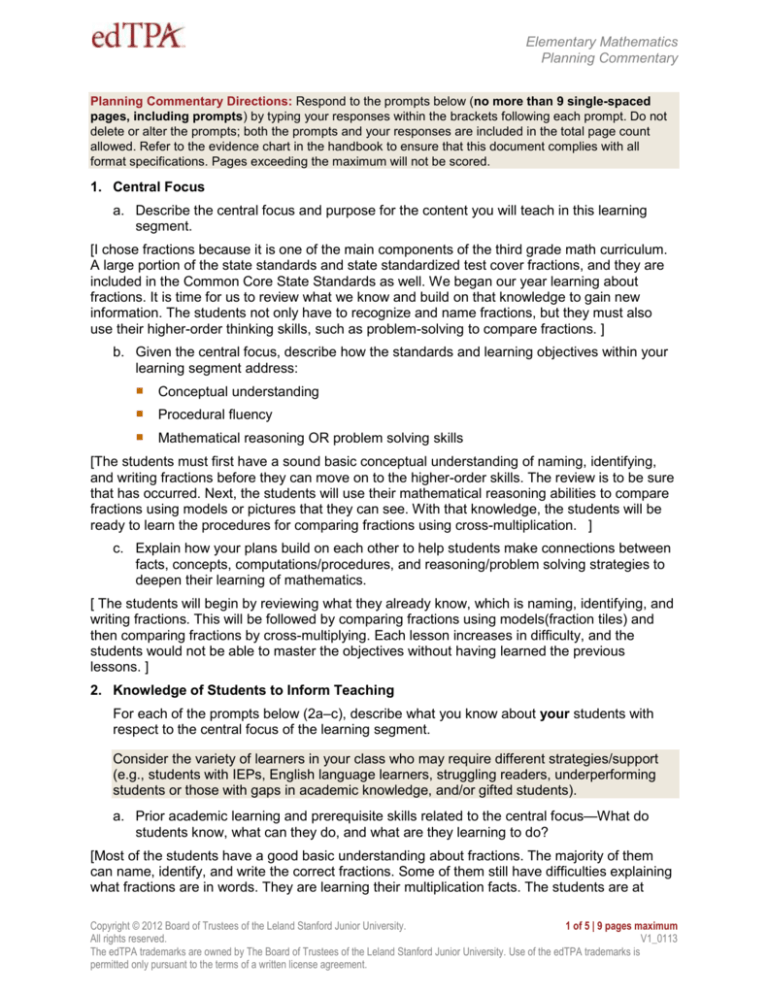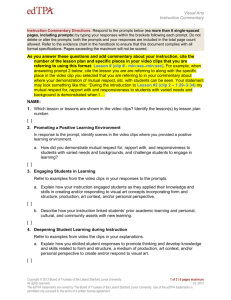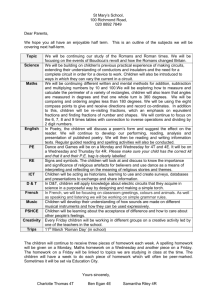
Elementary Mathematics
Planning Commentary
Planning Commentary Directions: Respond to the prompts below (no more than 9 single-spaced
pages, including prompts) by typing your responses within the brackets following each prompt. Do not
delete or alter the prompts; both the prompts and your responses are included in the total page count
allowed. Refer to the evidence chart in the handbook to ensure that this document complies with all
format specifications. Pages exceeding the maximum will not be scored.
1. Central Focus
a. Describe the central focus and purpose for the content you will teach in this learning
segment.
[I chose fractions because it is one of the main components of the third grade math curriculum.
A large portion of the state standards and state standardized test cover fractions, and they are
included in the Common Core State Standards as well. We began our year learning about
fractions. It is time for us to review what we know and build on that knowledge to gain new
information. The students not only have to recognize and name fractions, but they must also
use their higher-order thinking skills, such as problem-solving to compare fractions. ]
b. Given the central focus, describe how the standards and learning objectives within your
learning segment address:
Conceptual understanding
Procedural fluency
Mathematical reasoning OR problem solving skills
[The students must first have a sound basic conceptual understanding of naming, identifying,
and writing fractions before they can move on to the higher-order skills. The review is to be sure
that has occurred. Next, the students will use their mathematical reasoning abilities to compare
fractions using models or pictures that they can see. With that knowledge, the students will be
ready to learn the procedures for comparing fractions using cross-multiplication. ]
c. Explain how your plans build on each other to help students make connections between
facts, concepts, computations/procedures, and reasoning/problem solving strategies to
deepen their learning of mathematics.
[ The students will begin by reviewing what they already know, which is naming, identifying, and
writing fractions. This will be followed by comparing fractions using models(fraction tiles) and
then comparing fractions by cross-multiplying. Each lesson increases in difficulty, and the
students would not be able to master the objectives without having learned the previous
lessons. ]
2. Knowledge of Students to Inform Teaching
For each of the prompts below (2a–c), describe what you know about your students with
respect to the central focus of the learning segment.
Consider the variety of learners in your class who may require different strategies/support
(e.g., students with IEPs, English language learners, struggling readers, underperforming
students or those with gaps in academic knowledge, and/or gifted students).
a. Prior academic learning and prerequisite skills related to the central focus—What do
students know, what can they do, and what are they learning to do?
[Most of the students have a good basic understanding about fractions. The majority of them
can name, identify, and write the correct fractions. Some of them still have difficulties explaining
what fractions are in words. They are learning their multiplication facts. The students are at
Copyright © 2012 Board of Trustees of the Leland Stanford Junior University.
1 of 5 | 9 pages maximum
All rights reserved.
V1_0113
The edTPA trademarks are owned by The Board of Trustees of the Leland Stanford Junior University. Use of the edTPA trademarks is
permitted only pursuant to the terms of a written license agreement.
Elementary Mathematics
Planning Commentary
different places of mastery on these, based mostly on the amount of time that they have spent
practicing. For some of my inclusion students, it is related to their learning disabilities, and they
were already struggling mathematically. ]
b. Personal/cultural/community assets related to the central focus—What do you know
about your students’ everyday experiences, cultural backgrounds and practices, and
interests?
[One way to make fractions relatable to my students is to discuss how fractions are used in
cooking and baking, as many of them do with family members. Another way is to talk about how
fractions can be used in measuring and building things like they may also do with relatives.
Since this is a rural community, we have little cultural diversity in our classroom. Some of the
children’s interests include video games, books, art/drawing, and sports.]
c. Mathematical dispositions related to the central focus—What do you know about the
extent to which your students
perceive mathematics as “sensible, useful, and worthwhile,”1
persist in applying mathematics to solve problems, and
believe in their ability to learn mathematics?
[The majority of my students seem to like math and enjoy it. I will occasionally see some of them
attempt to solve problems out using fractions. It may not always be correct, but I can tell that
their minds are walking down that path. My students have displayed confidence when dealing
with fractions. ]
3. Supporting Students’ Mathematics Learning
Respond to prompts below (3a–c). As needed, refer to the instructional materials and lesson
plans you have included to support your explanations. Use principles from research
and/or theory to support your explanations, where appropriate.
a. Explain how your understanding of your students’ prior academic learning and
personal/cultural/community assets (from prompts 2a–b above) guided your choice or
adaptation of learning tasks and materials.
[Based on what I know about children in general and my students specifically, I wanted to
include activities that would interest them, such as blowing bubbles with chewing gum, while
getting them actively engaged, like when they are doing the motions for “multiply the butterfly” or
“bottoms up.” I know that they will learn better if they are involved in hands-on learning instead
of listening to me talk the whole time. Educational theorist Ralph Tyler (2008) believed that
children learned best through hands-on experiences (Misencik, p.4). I included opportunities for
the students to engage in collaborative learning by way of learning centers and completing work
as a group, which is encouraged by the Constructivists (www.thirteen.org, n.d.). This allows the
students to learn from each other and discuss fractions. Since this is the age of technology and I
have students who are very involved in video games, I also try to include technology into my
lessons whenever possible, and this learning segment was no different. I used several methods
of technology and visual aids. Some of Piaget’s suggestions included using visual aids and
giving the students hands-on and varied experiences (Mclendon, n.d.]
1
From the Common Core State Standards for Mathematics
Copyright © 2012 Board of Trustees of the Leland Stanford Junior University.
2 of 5 | 9 pages maximum
All rights reserved.
V1_0113
The edTPA trademarks are owned by The Board of Trustees of the Leland Stanford Junior University. Use of the edTPA trademarks is
permitted only pursuant to the terms of a written license agreement.
Elementary Mathematics
Planning Commentary
b. Describe and justify why your instructional strategies and planned supports are
appropriate for the whole class and students with similar or specific learning
needs.
Consider students with IEPs, English language learners, struggling readers,
underperforming students or those with gaps in academic knowledge, and/or gifted
students.
[While I think that learning centers and collaborative group work are very important to children
being successful learners, I also feel that whole-group instruction is just as important. The
lessons that I taught as whole-group were activities that I felt the students would learn more
from by us doing them together as a class. In whole-group instruction, I try to incorporate
technology and visual aids whenever possible to reach visual as well as audio learners. As I
stated in the previous question, it can also be helpful in holding the attention of some students. I
think that this is especially beneficial for my inclusion students or any students who may be
having difficulty with that particular objective. As we work through our lessons together, I usually
put the problems and answers as we work them out on the whiteboard or document camera.
When I place a document under the document camera, it is projected onto the Smart Board,
which enables greater visibility for all of the students. It also allows both the students and the
teacher to have the ability to circle or write on the board so that it looks like it is on the paper.
Those students who sometimes struggle have extra opportunities to see not only the correct
answers but also how we arrived there. The students in the class may also see another way to
arrive at the answer than mine by hearing what others have to say during class discussions, and
they even get a variety of answers for open-ended questions.]
c. Describe common mathematical preconceptions, errors, or misunderstandings within
your content focus and how you will address them.
[Children have a hard time at this age understanding that if the numerator is the same, the
fraction with the smaller denominator is actually the greater piece of the whole. Once we have
reached the lesson about cross-multiplication, I will try to get the students to “multiply the
butterfly” every time just to check their answers. They also think at this grade level that they can
draw pictures to compare fractions, but I try to discourage that due to the fact that their parts are
almost never equal or drawn to scale. It is also difficult for the students to remember to multiply
diagonally from the bottom first, but I hope “bottoms up” will help that as well.]
4. Supporting Mathematics Development Through Language
a. Language Demand: Language Function. Choose one language function essential for
student learning within your central focus. Listed below are some sample language
functions. You may choose one of these or another language function more appropriate
for your learning segment:
Categorize
Compare/contrast
Describe
Interpret
Model
[Compare fractions.]
b. Identify a key learning task from your plans that provides students with opportunities to
practice using the language function. In which lesson does the learning task occur?
(Give lesson/day number.)
[The students will complete the Multiply the Butterfly Handout with the teacher in whole-group
instruction on Day 3, using cross-multiplication to compare fractions.]
Copyright © 2012 Board of Trustees of the Leland Stanford Junior University.
3 of 5 | 9 pages maximum
All rights reserved.
V1_0113
The edTPA trademarks are owned by The Board of Trustees of the Leland Stanford Junior University. Use of the edTPA trademarks is
permitted only pursuant to the terms of a written license agreement.
Elementary Mathematics
Planning Commentary
c. Additional Language Demands. Given the language function and task identified
above, describe the following associated language demands (written or oral) students
need to understand and/or use.
Vocabulary and/or symbols
Plus at least one of the following:
Syntax
Discourse
Consider the range of students’ understandings of the language function and other
demands—what do students already know, what are they struggling with, and/or what is
new to them?
[numerator, denominator, less than (<), greater than (>), equal to (=), equivalent, multiply
a/b <,>,= c/d
Fraction A (a/b) is less than/greater than/equal to Fraction B (c/d). The student would choose
the appropriate comparison.]
d. Language Supports. Refer to your lesson plans and instructional materials as needed
in your response to the prompt.
Describe the instructional supports (during and/or prior to the learning task) that help
students understand and successfully use the language function and additional
language identified in prompts 4a–c.
[Essential questions are asked during the lessons to identify the parts of the fraction or
language to be used in comparisons. At the end of Lesson 3, the students will put small posters
in their math journals that label fractions as part/whole and numerator/denominator and show
the steps for cross-multiplying to compare fractions. If any of the fractions compared are equal,
the teacher will ask the students for another word for that. If the students are unable to
remember equivalent, the teacher will prompt them or offer hints.]
5. Monitoring Student Learning
Refer to the assessments you will submit as part of the materials for Task 1.
a. Describe how your planned formal and informal assessments will provide direct
evidence of students’ conceptual understanding, computational/procedural fluency, and
mathematical reasoning/problem solving skills throughout the learning segment.
[ Informal assessments, conducted mostly through observations while the students are working
and during lessons, will allow me the opportunity to see how the students are progressing
through their mastery of the standards during the lesson. That will allow me to make
adjustments to my lesson if necessary or pull students aside for extra attention as needed.
Homework assignments, which will also be used for formative assessment, will let me see how
well the students truly understood the lesson and how well they were able to complete the tasks
independently. The quizzes and tests can be used as both formative assessment to help me
make future decisions about my teaching and my students and as summative assessment to be
used as grading purposes and determination of mastery of the standards.]
b. Explain how the design or adaptation of your planned assessments allows students with
specific needs to demonstrate their learning.
Copyright © 2012 Board of Trustees of the Leland Stanford Junior University.
4 of 5 | 9 pages maximum
All rights reserved.
V1_0113
The edTPA trademarks are owned by The Board of Trustees of the Leland Stanford Junior University. Use of the edTPA trademarks is
permitted only pursuant to the terms of a written license agreement.
Elementary Mathematics
Planning Commentary
Consider all students, including students with IEPs, English language learners,
struggling mathematics students, underperforming students or those with gaps in
academic knowledge, and/or gifted students.
[The students will participate in learning centers with their peers. This will require little reading,
which is the main difficulty that most of my inclusion students have, and they are able to
complete the activity with the assistance of their peers if they encounter any problems. In the
Fish Bowl Math Craft, the students will complete the activity as a group, so all of the members
may again aid one another if anyone faces difficulty. This is another assessment with little
reading. The whole-group lesson activities allow the inclusion students to answer any questions
without having to read aloud if they do not want to, and they can work it out with me by their
sides to be sure they are on the right track. The quizzes and tests either do not have many
words or do not have very difficult words. However, all of my inclusion students with an IEP
have most graded work read to them. I also have tests with a reduced number of answer
choices for the students who need them.]
Copyright © 2012 Board of Trustees of the Leland Stanford Junior University.
5 of 5 | 9 pages maximum
All rights reserved.
V1_0113
The edTPA trademarks are owned by The Board of Trustees of the Leland Stanford Junior University. Use of the edTPA trademarks is
permitted only pursuant to the terms of a written license agreement.






